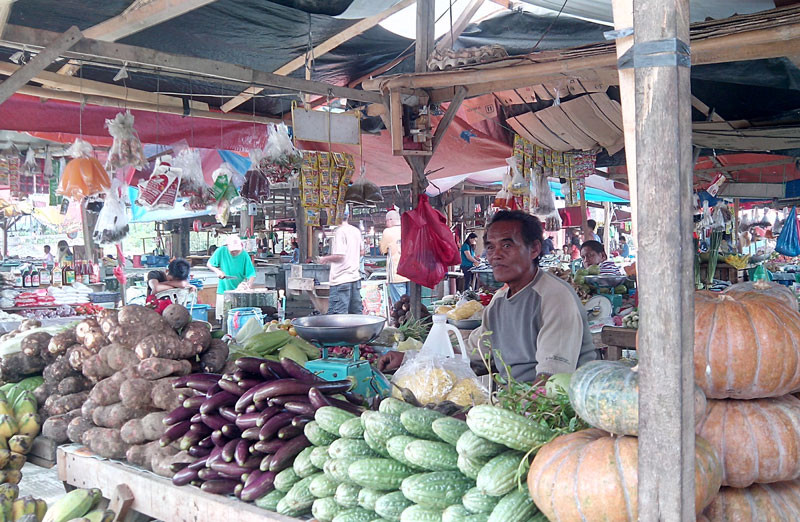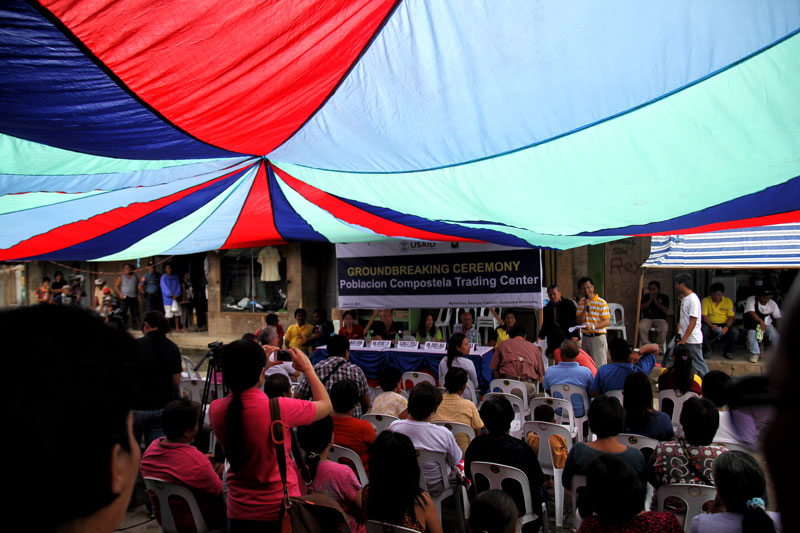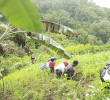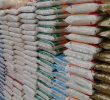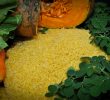“Siguro nasa 20 percent pa tayo (ng recovery), malaki pa masyado (ang hahabulin) lalo na sa agriculture.” — Compostela Valley Governor Arturo Uy
By JOHN RIZLE L. SALIGUMBA
Davao Today
COMPOSTELA, Compostela Valley, Philippines — More than six months after typhoon Pablo stuck the province of Compostela Valley, the people here still find it difficult to make both ends meet.
In Compostela town, for example, food produce had been very minimal after the farms were damaged by the typhoon. Market vendors had to buy their goods in Tagum City, part of the adjacent province which is a two-hour travel by land.
With the additional transportation costs, goods were expectedly sold at much higher prices to the Comvaleños.
“Tag 80 pesos per kilo ang talong sa Tagum, bale 10 pesos matag gramo ang baligya namo [We bought eggplants in Tagum City at PHP 80 per kilo, then we sold it at PHP 10 per gram (or PHP 100 per kilo) in Compostela],” said Abing Bacalso, 65.
Because the locals were still reeling from the typhoon, vendors can’t expect that all, if not most, of their goods will be sold.
“We have no other source of income. There are those who lend you money but with a very high interest rate. That would bury us in debt,” Bacalso, who’s sending three children to school, lamented.
Things went a bit better after, he said, after the Department of Agriculture (DA) distributed seeds to farmers. Many have planted vegetables for their personal consumption. They then sell their surplus produce at the local market for additional income.
Thus, the local market has been flooded with vegetables. But for small-scale vendors like Bacalso, this is also a downside.
“Karon mga 15 o 20 pesos kada kilo na lang among baligya sa talong diri. Sobra na pud ka barato kay halos tanan gapamaligya, malata nalang kay wala nay mamalit (Now, we’re selling eggplants at PHP 15 to 2o per kilo. It’s already very cheap since almost everybody is selling. And because nobody’s buying, our vegetables just wilt),” he lamented.
The economy of the province, before typhoon Pablo, mainly depended on the banana plantations. However, because of the impact of the natural calamity, many farmworkers were left with little or no job at all.
“Ang kahimtang dinhi hinay-hinay na nga nagasubida. Apan ang mga (gagmayng) negosyente nag-ilaid lang gihapon tungod ang mga trabahante wala pay trabaho, wala pay saktong sweldo (Our situation here has slowly improved. But small businessmen are still facing difficulties as workers still have no jobs, they don’t have enough salary),” Tony Simbre, president of the vendors association, said.
While at this, he appealed to the local government to repair their town’s wet and dry market because it suffered heavy damage because of Pablo.
Just recently, the United States Agency for International Development (USAID) held a ground breaking ceremony here for its trading center project in Poblacion village.
The foreign agency has poured PHP 2.5 Million (USD59,500) “to help restore safe and efficient commerce” in this town. The structure was designed to withstand extreme weather conditions and is said to benefit 23,000 residents in the said village alone.
“Kaning bagsakan masuwayan jud nato kay wala man ta gitukoran og bagsakan diri kung wala miabot ang bagyong Pablo (It remains to be seen if the new trading center can withstand the future typhoons. If not for Pablo, this project will not materialize),” commented another vendor Emmanuel Villarimo.
While vendors were happy with the project, the fact remains that locals and the entire province need more help.
Recovery at one-fifth
“Siguro nasa 20 percent pa tayo (ng recovery), malaki pa masyado (ang hahabulin) lalo na sa agriculture (Perhaps, we’re still at 20 percent recovery. There’s still more to be done especially in the agriculture sector),” admitted re-elected Compostela Valley governor Arturo Uy.
Many farmers, he said, are eager to plant trees and crops but they ran out of seedlings.
“Nagkaroon ng (mga) bagong tanim yung farmers. Ang nagtatanim ng mga banana noon, mga coconut na natumba, yung mga fruit trees, ngayon karamihan gusto magtanim ng cash crops yung madali na mapagkitaan like corn, vegetables and other high-valued crops (Farmers have new crops. Those who used to plant bananas, coconuts and other fruit trees that were damaged by Pablo, now want to plant cash crops like corn, vegetables and other high-valued crops for easy income),” Uy said.
The province, Uy added, also lacks farm machineries.
“Kinulang tayo ng makinaryas, (halimbawa) traktor, para mapadali ang pagtatanim nung farmers natin (We also lack equipment like tractors to help our farmers),” Uy said, noting the DA had let them borrow some tractors for some time.
But for Karlos Trangia, peasant-leader of the movement of Pablo victims Barug Katawhan, the farmers “need their own land to till,” first and foremost.
“Daghan man saop lang, maong dili maka-desisyon kung unsaon sa agalon ang ilang ginatikad nga yuta (Many are just tenants who are at the mercy of their landlords,” Trangia told davaotoday.com.
Domie Ginampas, 46, a recipient of the corn seeds and farm inputs of USAID, for example, said that he prepared a quarter of a hectare for a demo farm which he ploughed through an old-fashioned yet dependable way, that is, with a Carabao.
“But I am not the owner of this land. I am just a tenant,” he lamented.
Trangia also said farmers lack the financial capital to cultivate their lands and to grow the seedlings into crops or trees.
“Farmers have no source for daily sustenance much more for expenses for growing seedlings. Dili lang man na human og tanom, pasagdan na (You just don’t plant the seeds and then leave them afterwards),” he pointed out.
In March, the province proposed a PHP16 Billion rehabilitation plan, according to a news report. However, the said amount was trimmed down.
“Kasi napakalaki ng nasubmit natin. Siyempre, sa tingin naman ng Presidente (Noynoy Aquino), napakalaki ng amount. Baka hindi mabigyan lahat, so i-validate ilang beses (Because the amount of our proposal was very big. The government thought it had to go through a series of validation process),” Uy said, adding that the province already came up with a budget “that is realistic.”
However, he failed to give the exact amount, saying he doesn’t have the exact figures, yet. He said though Malacañang promised to give the budget for the shelter program and other infrastructure projects within the next three months. (John Rizle L. Saligumba/davaotoday.com)
compostela valley, ComVal, davao, Gov. Arturo Uy, Mindanao, news, philippines, typhoon Bopha, typhoon Pablo, United States Agency for International Development, USAID
